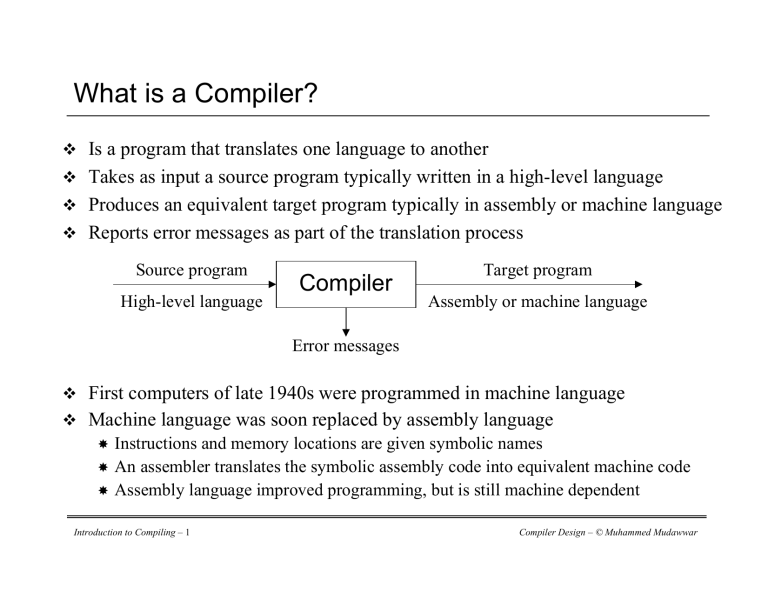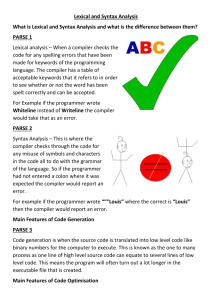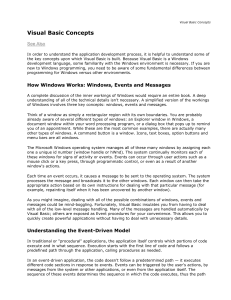What is a Compiler?

What is a Compiler?
c c c c
Is a program that translates one language to another
Takes as input a source program typically written in a high-level language
Produces an equivalent target program typically in assembly or machine language
Reports error messages as part of the translation process
Source program
High-level language
Compiler
Target program
Assembly or machine language
Error messages c c
First computers of late 1940s were programmed in machine language
Machine language was soon replaced by assembly language
\
\
\
Instructions and memory locations are given symbolic names
An assembler translates the symbolic assembly code into equivalent machine code
Assembly language improved programming, but is still machine dependent
Introduction to Compiling – 1 Compiler Design – © Muhammed Mudawwar
Brief History
c c c c c
The term “compiler” was coined in the early 1950s by Grace Murray Hopper
\ Translation was then viewed as the “compilation” of a sequence of routines selected from a library
The first compiler of the high-level language FORTRAN was developed between 1954 and 1957 at IBM by a group led by John Backus
\ Proved the viability of high-level and thus less machine dependent languages
The study of the scanning and parsing problems were pursued in the 1960s and
1970s and led fairly to a complete solution
\ Became standard part of compiler theory
\ Resulted in scanner and parser generators that automate part of compiler development
The development of methods for generating efficient target code, known as optimization techniques, is still an ongoing research
Compiler technology was also applied in rather unexpected areas:
\ Text-formatting languages
\ Hardware description languages for the automatic creation of VLSI circuits
Introduction to Compiling – 2 Compiler Design – © Muhammed Mudawwar
The Translation Process
c A compiler performs two major tasks:
\ Analysis of the source program
\ Synthesis of the target-language instructions c Phases of a compiler:
\ Scanning
\ Parsing
\ Semantic Analysis
\ Intermediate Code Generation
\ Intermediate Code Optimizer
\ Target Code Generator
\ Target Code Optimizer
Introduction to Compiling – 3 Compiler Design – © Muhammed Mudawwar
The Translation Process – Cont'd
c Three auxiliary components interact with some or all phases:
\ Literal Table
\ Symbol Table
\ Error Handler
Literal
Table
Source Code
Scanner
Tokens
Symbol
Table
Parser
Syntax Tree
Error
Handler
Semantic
Analyzer
Annotated Tree
Annotated Tree
Intermediate Code
Generator
Intermediate Code
Intermediate Code
Optimizer
Intermediate Code
Target Code
Generator
Target Code
Target Code
Optimizer
Target Code
Compiler Design – © Muhammed Mudawwar Introduction to Compiling – 4
Scanner
c The scanner begins the analysis of the source program by:
\ Reading file character by character
\ Grouping characters into tokens
\ Eliminating unneeded information (comments and white space)
\ Entering preliminary information into literal or symbol tables
\ Processing compiler directives by setting flags c Tokens represent basic program entities such as:
\ Identifiers, Literals, Reserved Words, Operators, Delimiters, etc.
c Example: a := x + y * 2.5 ; is scanned as a identifier y identifier
:= x
+ assignment operator identifier plus operator
*
2.5
; multiplication operator real literal semicolon
Introduction to Compiling – 5 Compiler Design – © Muhammed Mudawwar
Parser
c c c c c
Receives tokens from the scanner
Recognizes the structure of the program as a parse tree
\ Parse tree is recognized according to a context-free grammar
\ Syntax errors are reported if the program is syntactically incorrect
A parse tree is inefficient to represent the structure of a program
A syntax tree is a more condensed version of the parse tree
A syntax tree is usually generated as output by the parser assign-stmt a := x + y * 2.5 ;
id a := expr ; :=
Parse
Tree expr
id x
+ expr expr
* expr
id a
Syntax
Tree
+
id x *
id y literal 2.5
id y literal 2.5
Introduction to Compiling – 6 Compiler Design – © Muhammed Mudawwar
Semantic Analyzer
c c c c c
The semantics of a program are its meaning as opposed to syntax or structure
The semantics consist of:
\ Runtime semantics – behavior of program at runtime
\ Static semantics – checked by the compiler
Static semantics include:
\ Declarations of variables and constants before use
\ Calling functions that exist (predefined in a library or defined by the user)
\ Passing parameters properly
\ Type checking.
:= real
Static semantics are difficult to check by the parser
The semantic analyzer does the following:
\ Checks the static semantics of the language
\ Annotates the syntax tree with type information
id a real
Annotated
Syntax Tree
id x real
+ real int2real
id y integer
* real
literal 2.5
real
Introduction to Compiling – 7 Compiler Design – © Muhammed Mudawwar
Intermediate Code Generator
c c c c
Comes after syntax and semantic analysis
Separates the compiler front end from its backend
Intermediate representation should have 2 important properties:
\ Should be easy to produce
\ Should be easy to translate into the target program
Intermediate representation can have a variety of forms:
\ Three-address code, P-code for an abstract machine, Tree or DAG representation
:= real
id a real
Annotated
Syntax Tree
+ real
id x real int2real
* real
literal 2.5
real
id y integer
Three-address code temp1 := int2real(y) temp2 := temp1 real* 2.5
temp3 := x real + temp2 a := temp3
Introduction to Compiling – 8 Compiler Design – © Muhammed Mudawwar
Code Generator
c Generates code for the target machine, typically:
\ Assembly code, or
\ Relocatable machine code c c c c
Properties of the target machine become a major factor
Code generator selects appropriate machine instructions
Allocates memory locations for variables
Allocates registers for intermediate computations
Three-address code temp1 := int2real(y) temp2 := temp1 * 2.5
temp3 := x + temp2 a := temp3
Assembly code (Hypothetical)
LOADI
MOVF
R1, y
F1, R1
;; R1
← y
;; F1
← int2real(R1)
F2, F1, 2.5
;; F2
←
F1 * 2.5
MULF
LOADF F3, x
ADDF
;; F3
← x
F4, F3, F2 ;; F4
←
F3 + F2
STORF a, F4 ;; a
←
F4
Introduction to Compiling – 9 Compiler Design – © Muhammed Mudawwar
Code Improvement
c c c
Code improvement techniques can be applied to:
\
\
Intermediate code – independent of the target machine
Target code – dependent on the target machine
Intermediate code improvement include:
\
\
\
\
\
Constant folding
Elimination of common sub-expressions
Identification and elimination of unreachable code (called dead code)
Improving loops
Improving function calls
Target code improvement include:
\
\
Allocation and use of registers
Selection of better (faster) instructions and addressing modes
Introduction to Compiling – 10 Compiler Design – © Muhammed Mudawwar
Interpreter
c c c c c c c
Is a program that reads a source program and executes it
Works by analyzing and executing the source program commands one at a time
Does not translate the source program into object code
Interpretation is sensible when:
\ Programmer is working in interactive mode and needs to view and update variables
\ Running speed is not important
\ Commands have simple formats, and thus can be quickly analyzed and executed
\ Modification or addition to user programs is required as execution proceeds
Well-known examples of interpreters:
\ Basic interpreter, Lisp interpreter, UNIX shell command interpreter, SQL interpreter
In principle, any programming language can be either interpreted or compiled
\ Some languages are designed to be interpreted, others are designed to be compiled
Interpreters involve large overheads
\ Execution speed degradation can vary from 10:1 to 100:1
\ Substantial space overhead may be involved
Introduction to Compiling – 11 Compiler Design – © Muhammed Mudawwar
Programs Related to Compilers
c c c c c
Preprocessor
\
\
Produces input to a compiler
Performs the following: a a
Macro processing (substitutions)
File inclusion
Assembler
\
\
Translator for the assembly language
Two-Pass Assembly: a a
All variables are allocated storage locations
Assembler code is translated into machine code
\ Output is relocatable machine code.
Linkers
\
\
\
Links object files separately compiled or assembled
Links object files to standard library functions
Generates a file that can be loaded and executed
Debuggers
Editors
C or C++ Program
Preprocessor
C or C++ Program with macro substitutions and file inclusions
Compiler
Assembly code
Assembler
Relocatable object module
Linker
Other object modules or library modules
Executable code
Introduction to Compiling – 12 Compiler Design – © Muhammed Mudawwar
Major Data and Structures in a Compiler
c c c
Token
\
\
Represented by an integer value or an enumeration literal
Sometimes, it is necessary to preserve the string of characters that was scanned a For example, name of an identifiers or value of a literal
Syntax Tree
\
\
\
Constructed as a pointer-based structure
Dynamically allocated as parsing proceeds
Nodes have fields containing information collected by the parser and semantic analyzer
Symbol Table
\
\
\
\
\
\
\ Keeps information associated with all kinds of identifiers: a Constants, variables, functions, parameters, types, fields, etc.
Identifiers are entered by the scanner, parser, or semantic analyzer
Semantic analyzer adds type information and other attributes
Code generation and optimization phases use the information in the symbol table
Insertion, deletion, and search operations need to efficient because they are frequent
Hash table with constant-time operations is usually the preferred choice
More than one symbol table may be used
Introduction to Compiling – 13 Compiler Design – © Muhammed Mudawwar
Major Data and Structures in a Compiler
c Literal Table
\ Stores constant values and string literals in a program.
\ One literal table applies globally to the entire program.
\ Used by the code generator to: a Assign addresses for literals.
a Enter data definitions in the target code file.
\ Avoids the replication of constants and strings.
\ Quick insertion and lookup are essential. Deletion is not necessary.
c Temporary Files
\ Used historically by old compilers due to memory constraints
\ Hold the data of various stages
Introduction to Compiling – 14 Compiler Design – © Muhammed Mudawwar




